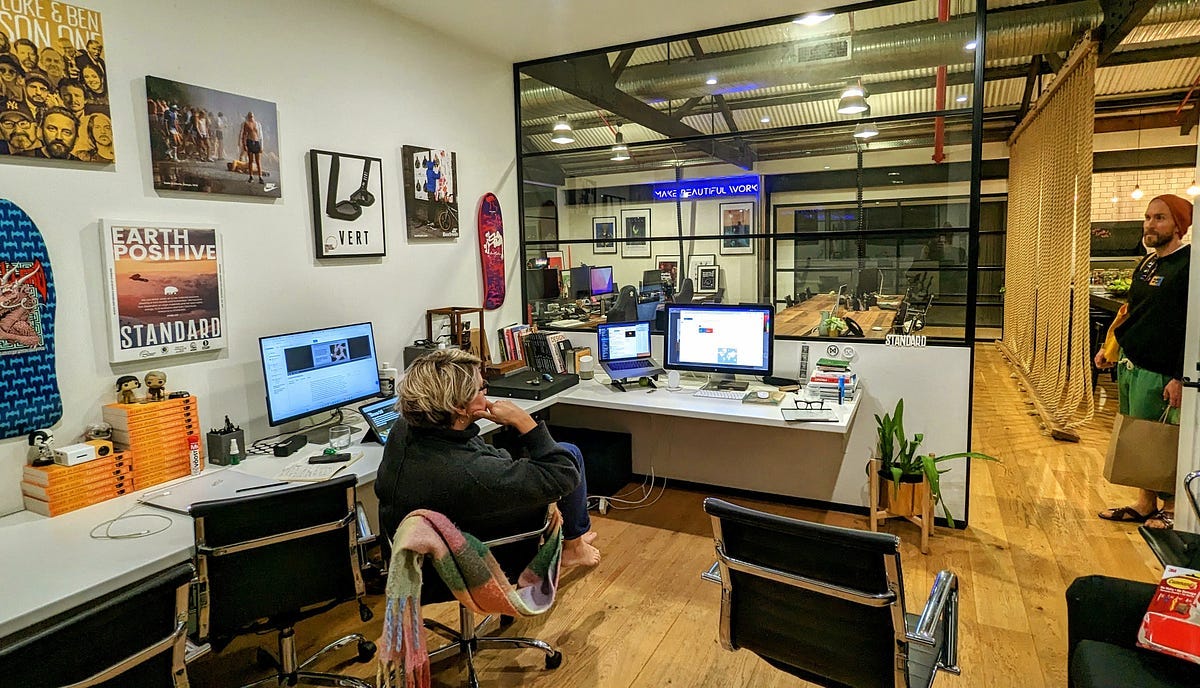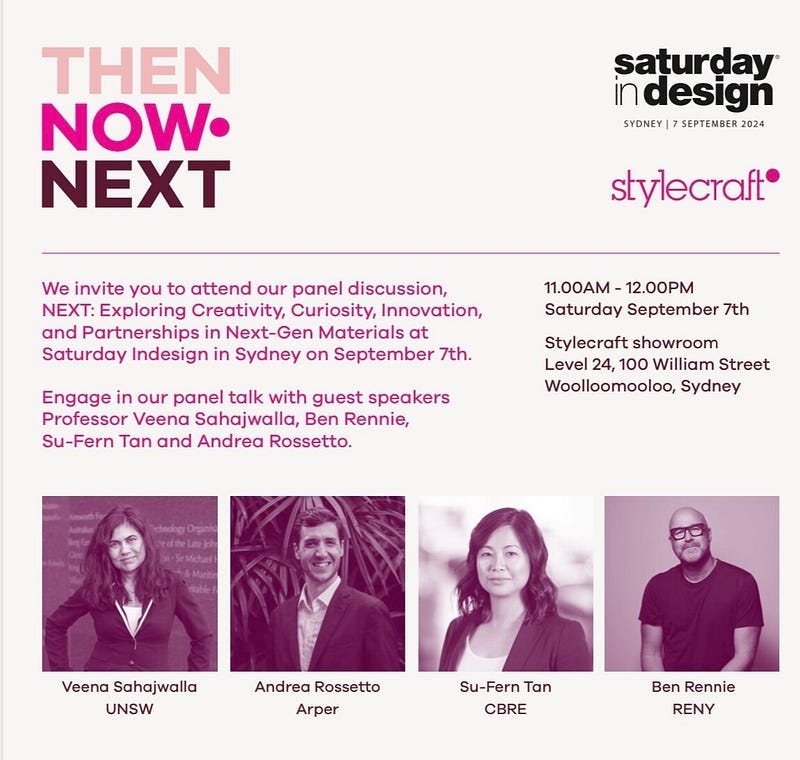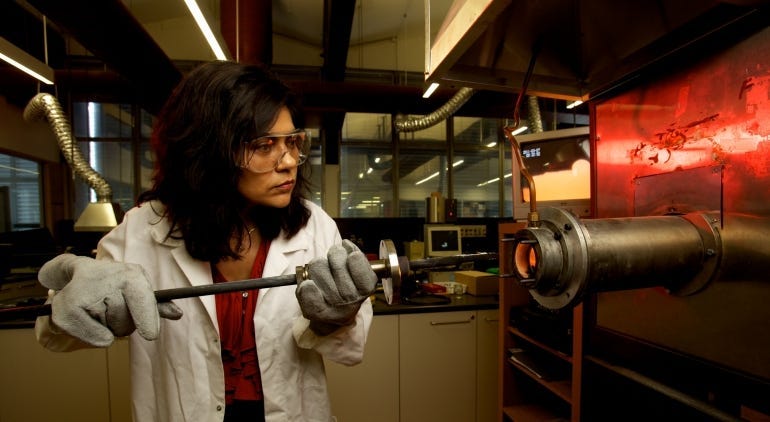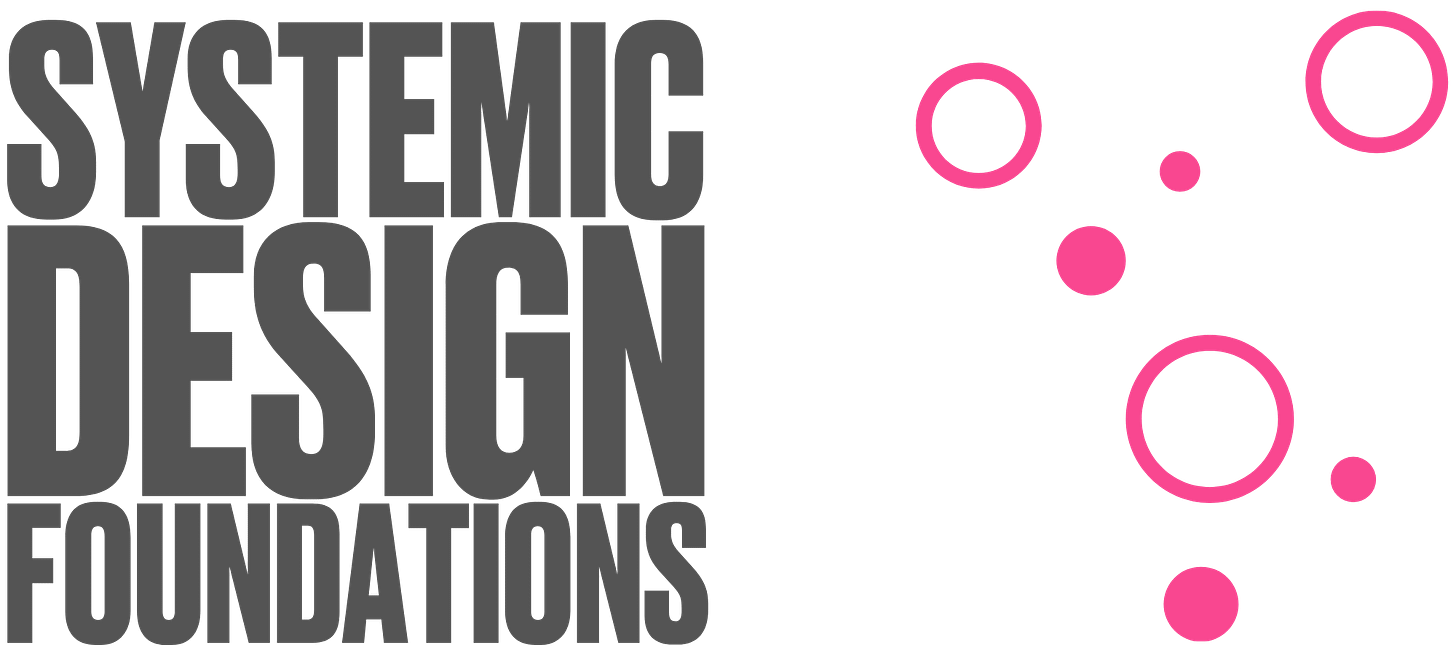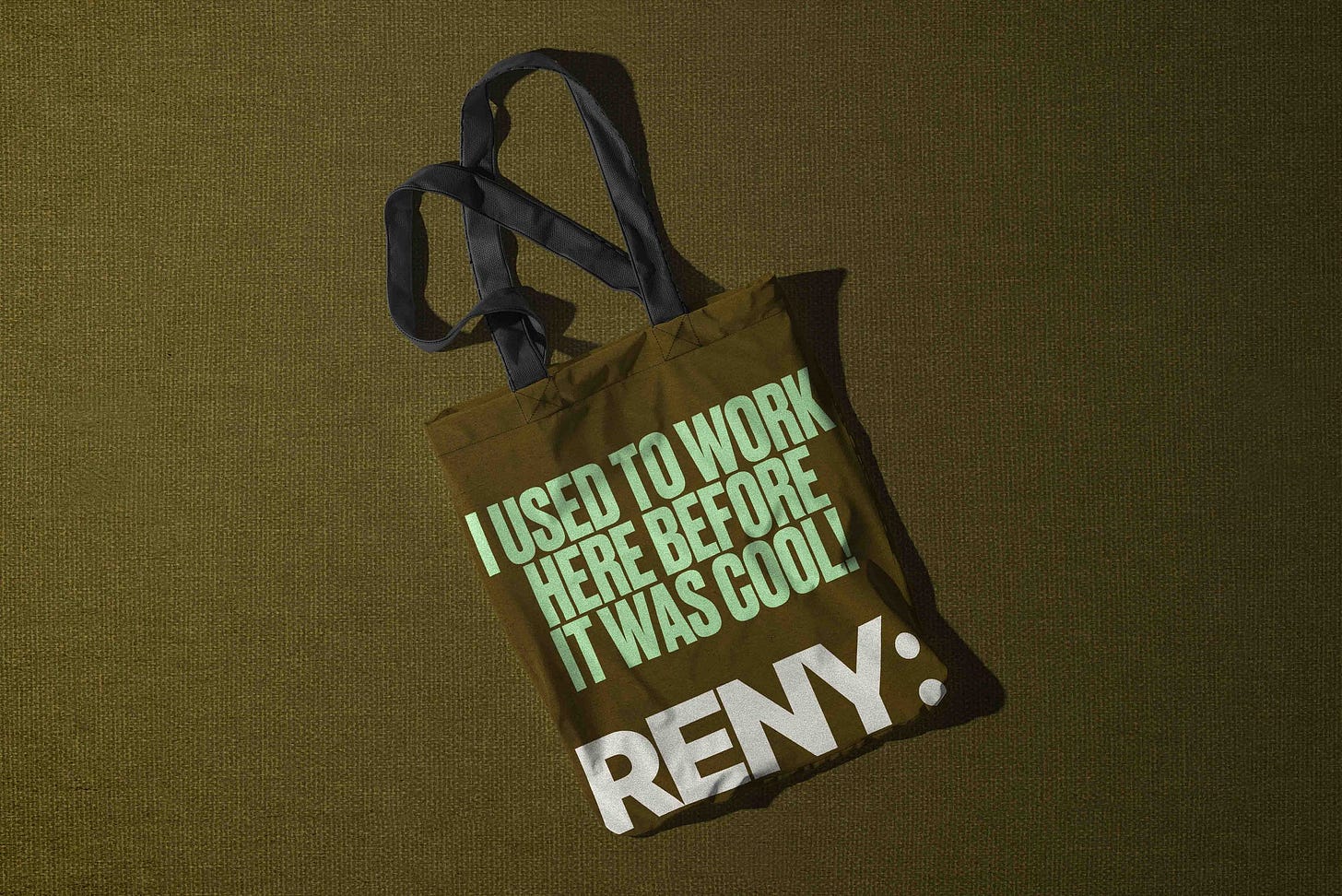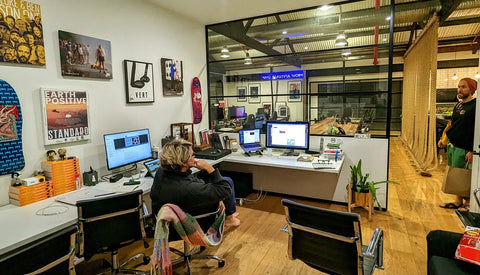
Big Goals Suck, Try This Instead!
My desk bears the clutter of old magazines — The Face, Vogue (90’s editions), iD, Sleeznation, Monocle, the defunct Arena, Smith Journal…
My desk bears the clutter of old magazines — The Face, Vogue (90’s editions), iD, Sleeznation, Monocle, the defunct Arena, Smith Journal, and stacks of books flanking my screen. They serve a purpose beyond my reflection on the 90's. They remind me that someone has addressed most problems I encounter in my work. They’re a collection of solutions, a library of past thoughts and endeavours. Flicking through the pages of old magazines and content is like a creative spark for my imagination.
Scattered among these are posters & canvases on my walls — some from brands I created that failed, successful ventures, and a few that never made it beyond the prototype stage. Toys, figurines, sculptures, and models fill my drawers & shelves. Why? Like the pages of my mags and books, each item tells a story, a narrative of attempts, failures, and successes. Each represents a moment in time, an idea that was brought to life by someone, somewhere.
My work never starts with a flash of inspiration. I wish it did. I am, in my self-definition, creatively suppressed. To think or draw inspiration from somewhere, I need space, a thing or a spark. More often than not, my ideas extend from someone else’s, extracted from old book pages or a library's muted aisles. Sometimes, sitting and watching people walk the streets is enough. I have spent a lot of time in bookstores and libraries from the local one around the corner or one I stumbled into during trips from Salt Lake City, LA, Tokyo or London. Each visit is a journey through shared human creation.
I have no genre, no favourite thing to read about, just a burning curiosity about how people before us solved the puzzles of their time. It’s like rummaging through an attic or an old antique store, finding old maps and notes left by explorers who’ve travelled similar paths.
This process isn’t academic — it’s deeply personal, learning from insights that span the decades and continents. There’s something beautiful about picking up where someone else left off, adding my piece to the puzzle, a small connection to the past.
Stuart Kauffman called it “the adjacent possible” — those moments where small, achievable changes lead to profound shifts. Inspired by his thinking, I look for ways to connect ideas that at first seem unrelated, but might just be the next steps we need to take, either in my business or in my personal life. I feel like those possibilities that lie just out of sight emerge when we dig a little deeper.
Last weekend, I had the privilege of joining a panel at the Stylecraft Then, Now, Next design event, alongside three of the most remarkable people I’ve shared a stage with. One of them was Scientia Professor Veena Sahajwalla from the University of New South Wales. Her opening remarks about molecules and science stretched my understanding of design and human behaviour in fascinating ways. In her explanation, Professor Veena emphasised everything comprises molecules, and she highlighted the power of human creativity in transforming the old into something new.
Professor Veena is a trailblazer in materials science, known for the invention of Polymer Injection Technology, or ‘Green Steel.’ This innovation, which repurposes waste into valuable materials, is just one aspect of her broader work with the Centre for Sustainable Materials Research and Technology. Since launching the first MICROfactory in 2018, she has been at the forefront of creating solutions that address the climate emergency.
Sitting next to Professor Veena, I couldn’t help but feel that my thoughts on creativity were light in comparison. But as the discussion unfolded, I realised we were circling the same core idea: the power of creativity to solve problems through transformation. A powerful reminder that creativity exists not only in groundbreaking innovations like Green Steel but in every idea realised and solution born from a humble ‘what if?’.
In his book, How We Got to Now, Steven Johnson shifts the focus from molecules to innovation. He illustrates how every item around us, from the kettle to the monitor you’re reading this from, carries the seeds for future inventions. What was once the endpoint of a previous designer now serves as our starting line. This continuous cycle allows us to transform old ideas into new realities. However, creation isn’t as straightforward as it seems; history is littered with designs that address immediate, visible problems but often overlook broader implications or unintended consequences.
Lately, I’ve been reflecting a lot on the shortcomings of design thinking and human-centred design. Despite their noble aims, there’s an inherent flaw in how we apply these processes — they don’t always consider the broader impact of our creations. Just as Professor Veena Sahajwalla’s innovative approach has revolutionised materials science, we need a similar fresh perspective in design thinking itself. It’s time to reassess not just what we create but the methods we employ to create, ensuring our designs are as sustainable and thoughtful as they are innovative.
We have a problem with creativity, and it’s not creativity itself — it’s us humans. If you’ve followed my previous writings, you’ll know that while 96% of children consider themselves creative, only 26% of adults feel the same. Why does this change happen? What happens to our creative spark as we grow up? One of my lifelong heroes, the late Sir Ken Robinson, blamed educational systems for this decline. He argued, “We are stifling people’s creative capacities through education… We don’t grow into creativity, we grow out of it, or rather, we get educated out of it.”
Inspired by Sir Ken, I love exploring the mechanics of creativity, focusing on the design process. In searching for solutions, I developed three core principles as a small part of the concept I call Re360 (or Systemic Design Foundations) — acknowledging that naming isn’t my strongest suit, or is it? These principles aim to transform our approach. Here are the top 3 things I like to think about the most.
1. Start with outcomes: We need to clarify what problem we’re trying to solve and envision the intended impact of our solutions.
2. Draw from existing knowledge: Innovation doesn’t always mean starting from scratch. More often, it means building on what already exists, integrating and transforming it to serve current needs. Continuous improvement is as vital, if not more so, than spontaneous innovation.
3. Focus on systems: Every component we design should serve multiple, meaningful purposes, for example, humans, and the planet. Simple, singular solutions aren’t enough; our challenges demand more complex, integrated responses.
The modern culture celebrates the ‘big and bold’. We often overlook the power of small, significant steps — those minor, practical experiments that accumulate into substantial change. This oversight isn’t just about setting goals; it’s about rethinking how we define and engage with creativity.
As designers, we have direct access to the decision-makers in organisations that shape our world. Tasked with thinking creatively, we’re called upon when transformation is the end goal. Our insights can alter how businesses and organisations perceive themselves, setting off a domino effect of change across various aspects of their operations. I wonder why we only seem to engage when the situation becomes critical. Why aren’t we constantly addressing issues, and applying our creative thinking to evolve ongoing strategies rather than reacting to crises?
Perhaps the answers lay in the corporate world’s obsession with big fat goals, often prioritising growth at any cost. As our planet faces unprecedented challenges, this mindset is coming under scrutiny. In 2012, they asked me to write a book on innovation. Throughout my research phase for the book, I interviewed 12 CEOs from some of Australia’s leading businesses. It became apparent that our leaders had different interpretations of innovation. I opened every interview with the same questions. So how do you define innovation? The responses from my first 12 interviews were all different, innovation to them related to the specific task or role that the business was engaged to do, innovation, which seems obvious, was ambiguous and forever changing according to the leader's role and responsibility directly related to how they saw innovation. During the 13th interview, with one of Australia’s leading CEOs (yes, you know him); he linked innovation to money and growth at all costs. (To write his total answer would put me over my word count here and risk getting me sued), so I will keep it short. According to him, innovation was often driven by greed.
After 3 months of writing, I renamed the book the “Innovation Myth”… after a further three months, I downed tools on it. The world didn’t need this book, nor did I want to write it. I learned that innovation isn’t the answer, creativity is.
The Government and big companies will shout the opportunities from monumental innovations. Sure, innovation is an opportunity. But innovation starts somewhere small, far from the confinement of big board rooms or post-it notes. It starts over coffee in the mooring, in the shower, or at that moment when something you brought didn’t feel right.
I shifted my thinking from innovation and big ideas to more straightforward solutions to the problems that confront us daily. Problems that felt personal, honest, and within my control. No one controls innovation. That’s an outcome of a lot of moving parts, in particular, creativity.
Consider this: there are 8 billion people on Earth, with about 5.846 billion adults. Research suggests that only 26% of these adults consider themselves creative, which accounts for about 1.520 billion individuals. That’s a tremendous amount of creative potential, untapped. In my book, I explore what happened to the creative confidence of the remaining billions who, somewhere along the way, forget they possess this innate capability.
I’ve spent years writing about creativity and our capacity for it, which I explore in depth in my book, Inhabitus. The insights I’ve gained aren’t straightforward but reveal profound truths about human nature and our relationship with creativity.
One evening, over a few too many glasses of red wine, an old friend confessed across my dining table he was embarking on making a short film about domestic violence. He was embarking on his filmmaking journey. As he outlined his ambitious plans, I couldn’t help but feel impressed. “That’s incredible — you’re a filmmaker,” I told him.
He chuckled, shaking his head. “I haven’t made anything yet,” he replied.
“But you’re making a film,” I said. “That intention, that effort defines you as a filmmaker, not just the end product.” Our conversation, fuelled by wine, meandered through several enthusiastic debates about what constitutes what and ended with about a dozen “I love you, man”, and “No, I love you” exchanges. Essentially, not solving anything other than an undeniable love for each other (and red wine).
Having made three films, he is reluctant to label himself as a filmmaker, but when he does, he credits the completion of those films as the reason for earning that title. I hold a different opinion. To me, he was a filmmaker from the moment he committed to the idea. This illustrates what I call ‘creative confidence’ — a term popularised by IDEO, but one that I adopt in my discussions about creativity (my creative confidence says right, I like that phrase, I own that now)!
This exchange is pivotal, as it highlights the essence of creative confidence: recognising how important the process is, not just the outcome. If we wait to start something only when we’re sure we can finish it, we might never begin. This hesitation, rooted in a fear of failure or incomplete projects, paralyses many potential creatives (or people who don’t think they are creative). What if the end didn’t matter? What if peer review of our success didn’t matter? Maybe the focus would shift from finishing to engaging — embracing each step of the creative journey, irrespective of the outcome. Better to be 1% closer to solving the climate emergency than never starting at all, right? Right!
I admit it: I’m a strong starter but a terrible finisher. I thrive on the excitement of new ideas and the initial stages of a creative project — the challenge of solving a problem and envisioning a new future. On the last stretch, I get bored, making me a bad finisher. As a result, embarking on any project terrifies me. I often struggle in the last 10% of the work, feeling like I spend 90% of my time on the last stretch of a job. I often find it challenging to keep my head above water in the last 10%.
I sought the help of a professional life coach to help me fix that, helping me to change my approach. I no longer try to push through to the end on my own. Instead, I bring in “finishers” — those rare and invaluable people who excel in closing projects. They help fill the gaps I leave, ensuring that the project crosses the finish line in its best form.
I’m obsessed with the glaring gap between the 96% of kids who see themselves as creative and the 26% of adults who feel the same. If you’re stuck in this middle ground, it might be because you’ve either never taken the plunge with that idea you had, or maybe you did and it didn’t pan out. Maybe someone laughed at you or told you couldn’t do it or perhaps, you believed that you didn’t have what it takes.
New ventures are tough and they become even tougher when the critics from the sidelines weigh in on your chances of success. But let’s be honest, their negativity isn’t entirely their fault, and it’s not solely on you, either. Society has a nasty habit of branding those who don’t see projects through as failures, pigeonholing businesses that don’t make it, and blaming the founders.
Even though 60% of businesses don’t last beyond four years, we still need a scapegoat for these “failures” and label the dreamers as incapable. Sometimes things just don’t work out. I’m 15 years into my business and still figuring out how to make it work. And yes, the whispers about past failures still echo in office corners, cubicles, and social gatherings — “Did you hear about Ben? In 2003, he ran a $5 million business into the ground. What a failure.” (OK, maybe people don’t whisper that. That’s my little lizard brain constantly reminding myself of the same thing — I am working on that too)!
These whispers can become the narratives we believe about ourselves, but they overlook the inherent challenges of business, climate action, and even personal relationships — all of which are complex and difficult. Maybe we should redefine what it means to be successful in creative endeavours. Perhaps it’s not about reaching the finish line; it’s about daring to start, the bravery to bring a new idea into the world, and the wisdom to know when to seek help.
To confront my fear of finishing and the anxiety that comes with wrapping up projects, I sought help from Vashti Whitfield, a personal coach renowned for her ability to inspire and transform human potential. For the past two decades, Vashti has dedicated her life to empowering others, and she played a crucial role in helping me find my path.
Working with Vashti, I learned that moving forward requires looking back. She helped me confront and understand deep-seated fears, including challenging family dynamics with my narcissist brother, which played a role in my ability to lead with confidence. This process wasn’t just about facing old fears but about reshaping my future on my terms, setting boundaries that allow me to pick up unfinished projects and see them through without fear.
Through this journey, Vashti didn’t just help me develop my skills; she helped me transform my approach to life and work, proving that sometimes the key to completion is a renewed understanding of ourselves and our past.
We’re often encouraged to set big goals. But why? Why can’t our goals be simple, human, and important? Ken Robinson stated, “For most of us, the problem isn’t that we aim too high and fail — it’s just the opposite — we aim too low and succeed.” It’s the only quote from Ken I disagree with. Sometimes we need reachable, straightforward goals we can meet with certainty. Often, grand ambitions feel too distant, obscured by the fog of daily challenges. For some, getting out of bed in the morning is a significant achievement; for others, it’s buying a private jet.
This perspective extends beyond personal achievements. In a recent conversation with one of the smartest humans I know, one of my business colleagues was hesitant to speak up about the climate emergency. He felt he needed to build trust and accumulate achievements before he could have a voice and yield influence.
The perceived risk of speaking up often outweighs the actual danger. We carry this imagined burden daily, allowing our insights and creativity to diminish.
Like creativity, the ability to speak up is a skill honed through practice. It’s not about waiting for an invitation or seeking permission; it’s about having the courage and creative confidence to express your thoughts, ready or not.
In The Art of Possibility, Rosamund Stone Zander and Benjamin Zander share a story of two shoe salesmen sent to Africa. One reports back, “Situation hopeless. No one wears shoes,” while the other sees a prime opportunity, noting, “Glorious opportunity. They have no shoes.” This tale of two perspectives underscores how our outlook shapes our reality.
This concept resonates in the creative fields. Each journey is fraught with its challenges and obstacles. All hurdles are opportunities.
I am learning (in my almost 50s!) that discomfort never fades, so I try to used to it. I am slowly getting better at that. Discomfort might be a good thing. Dissatisfaction, while uncomfortable, can be a good genesis for creativity. It compels us to question and rethink.
In Creativity: The Psychology of Discovery and Invention, psychologist Mihaly Csikszentmihalyi highlights a crucial trait of creative individuals: the ability to find joy in the process or the journey. As Csikszentmihalyi notes, “Without this trait, poets would give up striving for perfection and write commercial jingles, economists would work for banks where they would earn at least twice as much as they do at the university, and physicists would leave basic research for industrial labs with better conditions and more predictable outcomes.”
This enjoyment of the process, this dedication to the journey, is where true creative confidence lives. It’s not about waiting until you’ve “made it” to claim your creative identity (or to speak up). It’s about recognising and embracing the creativity in your daily actions, the small choices, and the bold steps you take.
So, instead of grand, audacious goals (please, no more BeHAGs), let's focus on simple, human, meaningful goals. What if we celebrated minor acts of creativity? What if we rediscovered and appreciated that childlike confidence in our creative potential?
This shift in perspective could bridge the gap and reignite the creative spark in those who’ve forgotten their capabilities.
You don’t become creative by achieving a goal. You’re inherently creative. Because you’re human, because you’re trying, because you’re here, engaging with the world around you.
Your creativity (which leads to creative confidence) isn’t something you need to search for — it’s something you need to remember.
Start small. Start now. Start with what you have and where you are.
Creativity has no destination. It’s about the journey and we all know that the road to the places we dream about is where the magic happens.
Embracing these small, meaningful steps, you might achieve those big goals — not because you were chasing them, but because you were too busy creating to notice how far you’ve come.


